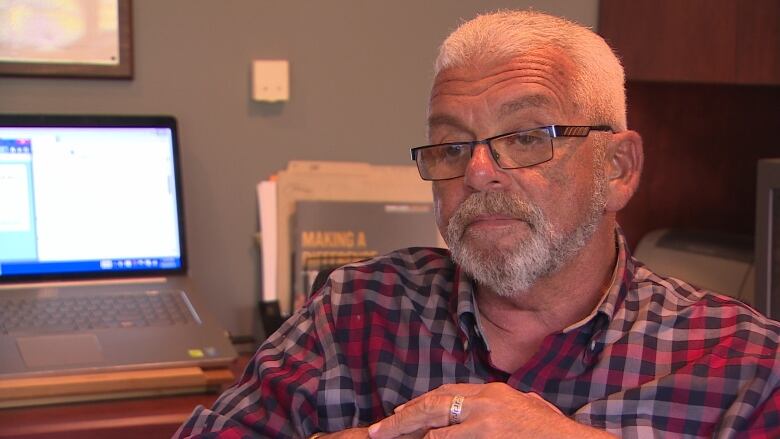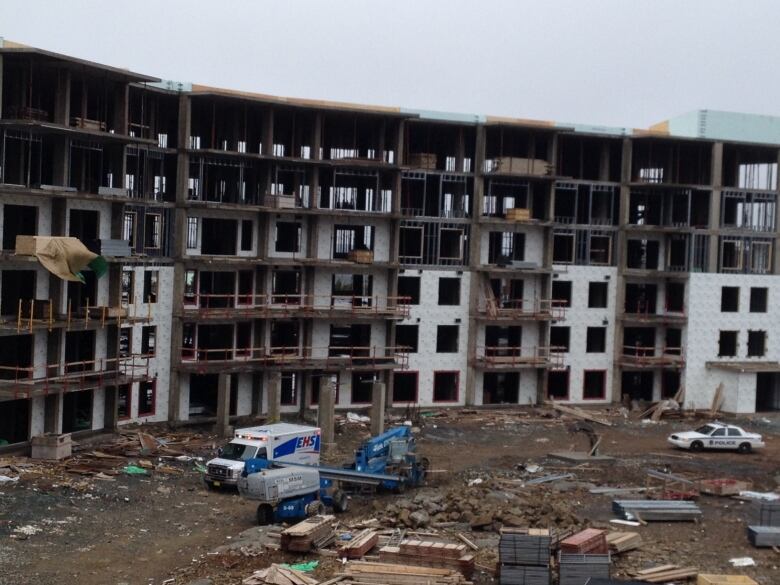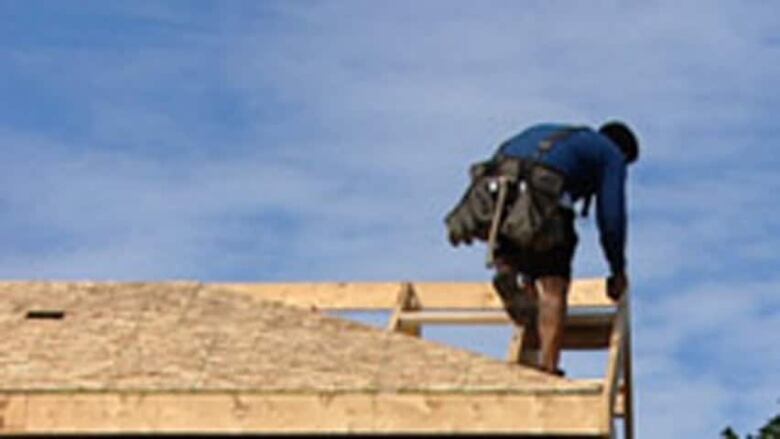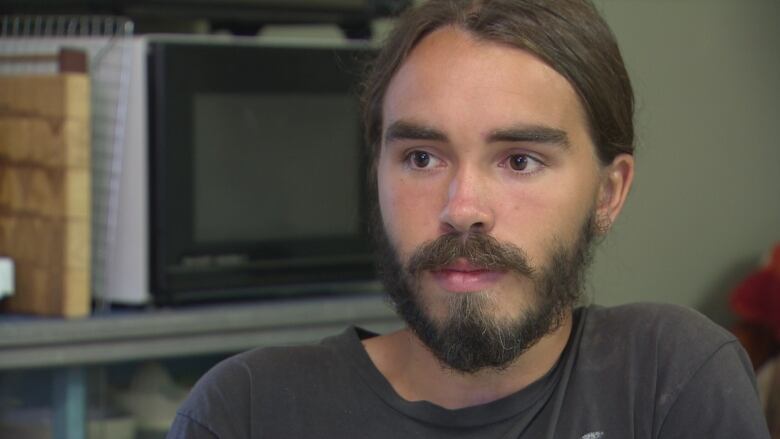Alan Fraser's death 'galvanized' construction safety in Nova Scotia
Cost of time loss claims for fall injuries is dropping

It's coming up on two years since Alan Fraser died, a fall that sent a chilling wave through the construction industry.
- Clayton Park construction victim's parents seek answers
- Construction sites need stricter oversight, say advocates
The worker fell from the roof of a sixstorey building under construction in Clayton Park in November 2013.
He was only 21.
According to numbers obtained by CBC News, the number of fall safety-related complaints and orders has risen since Fraser's death and the costs of claims are dropping.

Itshows things have gotten better, according topeople working in the industry.
"Absolutely. Absolutely we are safer," said Bruce Collins, head of the Nova Scotia Construction Safety Association.
SinceFraser'sdeath, the province changed regulations and hired more inspectors.
"Both myself and the [members] of the [Workers' Compensation Board] had children relatively in the same age group. The deputy minister at the Department of Labour at the time had children that went to school with Alan Fraser. So all of the key people who were working on these things, it kind of galvanized us to get this done and try harder to do what we do," Collinssaid.
More complaints called in
Since May 1, 2012, there have been more than 6,000 complaints from the public about workplace safety in general. More than half have resulted in work orders.

Of those complaints 1,600 involved fall safety and resulted in 1,106 work orders.
Those violations include not using a harness, unsafe gear and scaffolding, and not training employees before they started working.
The number of orders for fall protection violations spiked in 2014, a year after three construction workers, including Fraser, died in Nova Scotia.
"I do believe the tragic events that happened in 2013 kind of ramped up our efforts. It's definitely safe to say that," said Scott Nauss, senior director with the Department of Labour's occupational health and safety wing.
"When I see the number of fall protection orders increasing, I view that as a good thing. I view that as fall protections issues that are being corrected in the field."
Other common work orders issued were for chemical exposure, ventilation/sanitation, personal protective equipment and workplace violence.
"It does concern me that thousands of orders are being issued... but the numbers show we are a safer province. We really started to focus [in] 2013, post those fatalities, in the construction industry," said Nauss.
Time loss claims down
While the number of complaints rises, the number oftime-lost claims due tofall injuries are tumbling.
The Workers' Compensation Board of Nova Scotia offers benefits for injured workers, including health care costs and financial compensation for workers who can't return to their jobs.
According to the Nova Scotia Construction Safety Association, in 2010 52 people made claims worth a total of $619, 920. Last year that number dropped to 35 claims worth a total of $362, 849.
So far this year there have been 17 claims worth $70,142.
The number of deaths in the workplace has also fallen. In 2013, there were 17 workplace deaths. Fraser was one of three in the construction industry.
So far in 2015 there have been six workplace deaths.

The Workers' Compensation Board says one, a diving death, is classified as aconstruction industry fatality.
Nauss attributesthe numbers to more inspections in "high-risk" industries, hiring more staff (there are now 47 inspection positions), changes to fall protection regulations, including more training, a focus on young workers and construction blitzes.
Blitzes are when inspectors target employers working at heights for a week straight, across the province.
Nauss says before 2013 a blitz could reach about 10 to 15 employers, butnow they are hitting 60 to 75 across the province.
Collins says changes were already in the works before a trilogy of construction related deaths in the 2013 sent ripples through the industry, but it resonated with the decision makers at the time.
"Lots of public attention and a lot of demand for increased inspection," said Collins.
Claims still reported
The numbers are a cold comfort for Alex Wilbur-Knight.
Despite improvements, he says some companies are still willing to cut corners.
Wilbur-Knight says the cleaning company he worked for was sent up on an icy roof earlier this year.
It's too high a cost. In every way you measure it, in human life and dollars.- Bruce Collins
"I had no training for working with a safety harness and no safety harness was provided,either. When I asked them about it, basically what they told me was don't be seen or they'll be in trouble. So they knew what they were doing was wrong. They just were hoping they could get away with it," he said. "I didn't like it but I really needed the money at the time."
The 21-year-old said there was one harness for six workers.
Wilbur-Knight says he called the department to report the company he was working for, but wasn't interested in launching a full investigation.
He left the construction industry soon after.
"I didn't want to deal with that at the time."

Heather Cruickshanks, acting president of the Merit Contractors Association of Nova Scotia an association that represents non-unionized construction companies says the only way to go after people who still don't follow the rules is to have more people investigating.
"There was no reason for that death, not today. It should never have happened," she said.
"We have to have teeth. We have to be tougher with our penalties. But the penalty has to be consumed by the employer, the employee and the supervisor.
"These cases have to be brought public. The public has to know:this happened, here's the outcome."
Nauss says part of the department's new strategy is to target employers who have a history of violations.
Collins says every claim worries him, but addsthe province has moved from an "educate and wait" model to targeting problem contractors before tragedy strikes.
"We're telling the people who are having these problems on an ongoing basis that it's not acceptable anymore. It's too high a cost. In every way you measure it, in human life and dollars," he said.
"It's not good enough, but we're doing pretty good."
Earlier this year the Occupational Health and Safety division laid six charges against the company Fraser was working for.
Parkland Construction Inc. has been charged with providing a lack of fall protection, fall protection training and a safe work plan.
They were also charged with failure to ensure a chute is used to lower garbage.
They'll be back in court Sept.16 to enter a plea.












_(720p).jpg)


 OFFICIAL HD MUSIC VIDEO.jpg)
.jpg)



























































































